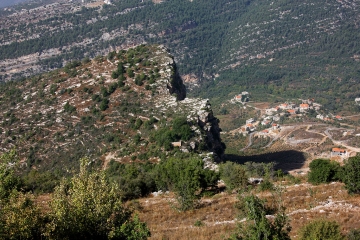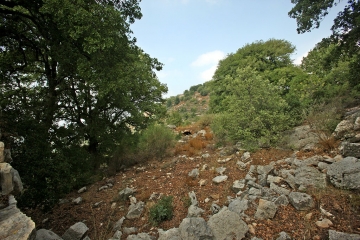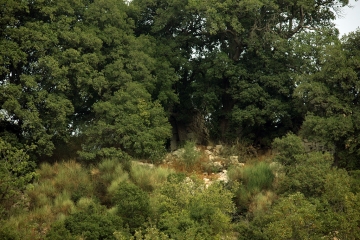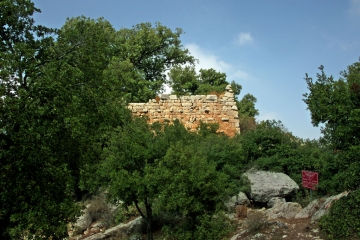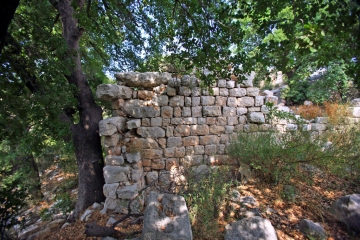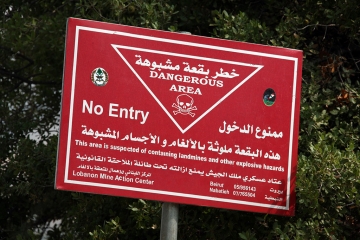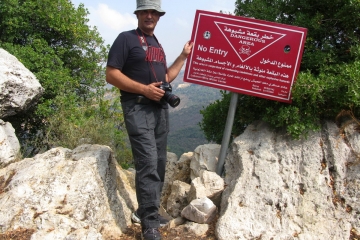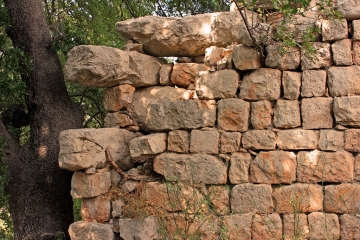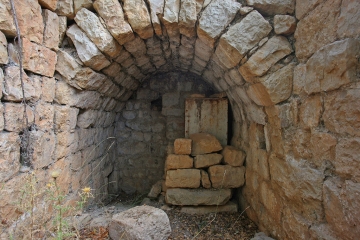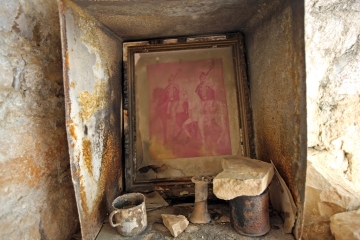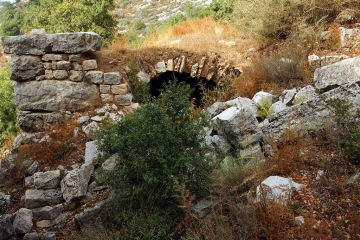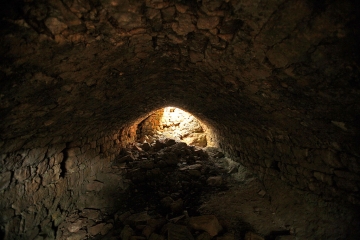دير مار سركيس القرن – حردين
تُعتَبَر حَردين أَوَّلَ قَريَةٍ لُبنانِيَّةٍ دِانَت بِالدِّيَانَةِ المَسِيحِيَّة، وَهيَ مَسقَطُ رَأسِ القِدّيسِ الأَبّ نِعمَةَ الله كَسَّاب المَعروف بِالحَردِينِيّ، وَهوَ مُعَلِّمُ القِدِّيسِ الأَوَّلِ، الأَبّ شَربِل مَخلوف، مِن بِقاعكَفرا
وَلِتَسمِيَتِهَا تَفسِيرَاتٌ عِدَّةٌ، فَأَكثَرُ البَاحِثِينَ وَالمُؤَرِّخِينَ يُجمِعُونَ عَلَى أَنَّ أَصلَ اسمِهَا سِريَانِيٌّ وَيَعنِي "الخَائِفُونَ" وَ"الوَجِلُونَ"، وَيُقصَدُ بِهِم الَّذِينَ يَخَافُونَ اللَّهَ وَيَتَّقُونَهُ، مُستَنِدِينَ فِي ذَلِكَ عَلَى أَنَّ جَذرَ "حَردٌ" يَعنِي الخَوفَ وَالهَلَعَ وَالارتِجَاف. هَذَا بَينَمَا اعتَبَرَ غَيرُهُم أَنَّ الاسمَ مُشتَقٌّ مِن مَقطَعَينِ سَامِيَّينِ: حَارٌّ وَيَعنِي النَظَرَ، وَدَينٌ أَي القَضَاءَ وَالحُكمَ. أَمّا الرُّهبَانُ فَيَرِدُّ بَعضُهُم أَصلَ هَذَا الاسمِ إلَى "حَارَّةِ الدِّينِ" او "حَارٌّ فِي الدِّينِ" لِكَثرَةِ الأَديَارِ وَالكَنَائِسِ هُنَاكَ، وَعَدَدِ الرُّهبَانِ وَرِجَالِ الدِّينِ وَالحُبَسَاءِ الَّذِينَ سَكَنُوا هَذِهِ القَريَةَ. وَفِي المُدَوِّنَاتِ قَبلَ المَسِيحِ وَرَدَ اسمُهَا "حَردُونَا"، وَفِي مُدَوِّنَاتِ القَرنِ الثَّالِث عَشَر المِيلَادِيِّ وَرَدَ "حَردُ
وكانَ البَطرِيَركُ دَاوُدُ الثَّانِي، المُلَقَّبُ بِيُوحَنّا، أن جَعَلَ مِن حَردَينِ مَركَزًاً لِلبَطرِيَركِيَّةِ المَارُونِيَّةِ قَبلَ أَن تَعُودَ الَى دير سيّدة إِيلِيج فِي العَامِ 1404. وَكَانَت قَبلَ ذَلِكَ مَركَزًاً لِبَطَرِيَركِيَّةِ اليَعَاقِبَةِ، إِذ سَكَنَهَا البَطرِيَركُ فِلِكسِينُوس دَاغِر الَّذِي كَانَت رَعِيَّتَهُ تَمتَدّ حَتَّى النَبَك فِي سُوريَا
وكَانَت حَردَينِ ضَحِيَّةً لِلصِّرَاعَاتِ الدِّينِيَّةِ وَالمَذهَبِيَّةِ مَرّاتٍ عِدَّة، خُصُوصًا فِي عَهدِ وُلَاةِ طَرَابُلُسَ إِذ أَحرَقَهَا أَحمَدُ الأَرنَاؤُوطِيّ، كَمَا شَهِدَت حَردِينُ بِدَايَةَ الصِّرَاعِ بَينَ اليَعَاقِبَةِ وَالنَسَاطِرَة عِندَمَا كَانَ يُسَيطَرُ عَلَيهَا السِّرَيَان
وَكَانَ لَهَا، خِلَالَ هَذِهِ الصِّرَاعَاتِ، بُطُولَاتٌ، وَلَعِبَ أَبنَاؤُهَا دَورًاً بَارِزًا. فَمُقَدَّمُهَا بِنيَامِين الحَردِينِيّ قَادَ فِرقَةً مِنَ المُقَاتِلِين، انتَصَرَت عَلَى المَمَالِيكِ فِي مَعرَكَةِ جُبَيل عَامَ 1306، وَأُسَرَ قَائِدَهُم حَمَدَانُ وَاستَرَدَّ المَدِينَةَ مِنهُم. لَكِنَّهُ دَفَعَ حَيَاتَهُ ثَمَنًا فِي المَعرَكَةِ المَذكُورَةِ، إِذ قُتِلَ قُربَ جِسرِ الفِيدَار... فَدُفِنَ عِندَ صَاحِبِ الأَركَانِ فِي جبِيلَ
وَحَردِينُ كَانَت مَأهُولَةً مُنذُ العَهدِ الفِينِيقِيِّ، إِذ عُثِرَ فِيهَا عَلَى خَمسِينِ نَاوُوسٍ مِنَ النَّوَاوِيسِ الفِينِيقِيَّةِ المَحفُورَةِ فِي الصُّخُور... وَالمُوَزَّعَةِ عَلَى أَحيَائِهَا الَّتِي كَانَت تَمُرُّ عِبرَهَا الطَّرِيقُ القَدِيمَةُ المَعرُوفَةُ بِ طَرِيقِ الشَّام الرُّومَانِيَّة
كَما قَد كانَت حَردينُ قِبلَةَ رِجالِ السِّياسَةِ وَالحَرب الَّذِينَ يَرغَبونَ فِي تَحصِينِ مَواقِعِهِم وَجَعلِ اقتِحامِها صَعبًا عَلى أَعدائِهِم، كَونَها تَتَمَيَّزُ بِمَوقَعٍ جُغرافِيٍّ مُقفَلٍ مِن ثَلاثِ جِهاتٍ، فَلا يُمكِنُ وُلُوجُهَا إِلاّ مِن مَنفَذٍ وَاحِد. لِذا اتَّخَذَها الرّومانُ حُصنًا لَهُم، وَبَنَى الإِمبَراطور الرّومانِيّ أَدرِيَان أَغُوسطِينُوس (117-138 م)، عَلَى أَعلَى قِمَّةٍ مِن جَبَلِها، قَصراً لَهُ، وَمَعبَدًا ضَخمًا لِإِلَه الشَّمسِ مَرقوريُوس أَو عُطَارَد... كَانَ يَتَأَلَّفُ مِن أَعمِدَةٍ هَائِلَةٍ يُرَاوِحُ عَدَدُها مَا بَينَ الثَّلاثِينِ وَالسِّتَةِ ثَلاثِين، وَهِيَ مِنَ الطِّرَازِ الأَيُّونِيِّ النَّادِرِ، إِلاّ أَنَّهَا تَهَدَّمَت بِفِعلِ عَوَامِلِ الزَّمَنِ، وَقَد عَمِلَت المُدِيرِيَّةُ العَامَّةُ لِلآثَارِ عَلَى إِعَادَةِ تَرمِيمِ مَا سَلِمَ مِن أَجزَائِها
وَقَد نُسِجَت حَولَ هَذَا المَعبَدِ أُسطُورَةُ إهتِدَاءِ سُكَانِ تِلكَ المَنطِقَةِ إِلَى الدِّيَانَةِ المَسِيحِيَّةِ عَلَى يَدِ إِبنَةِ المَلِكِ الوَثَنِيِّ المَعرُوفَةِ بِاسمِ "سَيِّدَةِ القَلعَة". كَمَا وُجِدَت فِيهِ بَلاطَةٌ صَخرِيَّةٌ ضَخمَةٌ رَمَادِيَّةُ اللَّون... تَمتَدُّ انحِدَارًا وَتَحتَوِي عَلَى عَدَدٍ كَبِيرٍ مِنَ المُتَحَجِّرَاتِ البَحرِيَّة. وَكَانَ هُنَاكَ قَولٌ شَائِعٌ قَدِيمًا وَهُوَ أَنَّ أَجمَلُ مَا فِي لُبنَانَ ثَلاثَةٌ: وَادِي قَنُّوبِينَ، وَقَصرُ بَيتِ الدِّينِ، وَبَلاطَةُ حَردِين
وَقَريَةُ حَردِينَ تَحتَوِي عَلَى عَدَدٍ كَبِيرٍ مِنَ الأَديِرَةِ وَالكَنَائِسِ وَالمَحَابِسِ، نَذكُرُ مِنهَا دَيرَ وَمَغَارَةَ مَار يُوحَنَّا الشَّقف الَّتِي تَعُودُ إلَى العَهدِ الصَّلِيبِيِّ، وَكَنِيسَتَهُ المَبنِيَّةَ عَلَى الطِّرَازِ اللَّاتِينِيّ. وَلَطَالَمَا كَانَ القِدِّيسُ نِعمَةُ اللَّه الحَردِينِيّ يَزُورُ المَغَارَةَ المُجَاوِرَةَ لِلدَّيرِ، بُغيَةَ الصَّلَاةِ وَالتَّأَمُّلِ، وَهِيَ تُعرَفُ بِاسمِ مَغَارَةِ القِدِّيسِ نِعمَة اللَّهِ
وَهُنَاكَ كَذَلِكَ كَنِيسَةُ مَار جِرجِس الأَثَرِيَّة، وَهِيَ رُومَانِيَّةٌ تَعُودُ إِلَى القَرنِ العَاشِرِ المِيلَادِيِّ. وَأَيضًا دَيرُ مَار فَوقَا، وَهُوَ أَثَرٌ سِريَانِيٌّ مِن أَقدَمِ أَديَارِ حَردِينَ إِذ يَعُودُ إِلَى القَرنِ السَّادِسِ، بَنَاهُ المَطَارِنَةُ السِّريَانُ يَومَ سَكَنُوا جَبَلَ حَردِينَ، إِذ أَنَّ حَردَينَ جَاءَهَا ثَلَاثَةُ مَطَارِنَةٍ سِريَان مِن بِلَادِ مَا بَينَ النَّهرَينِ وَسَكَنُوا جَبَلَهَا وَبَنَوا هَذَا الدَّيرِ عَلَى اسمِ القِدِّيسِ فَوقا
هَذَا بِالإِضَافَةِ إِلَى دَيرِ مَار سَركِيسَ القَرن الَّذِي هُوَ مَوضُوعُنَا الآنَ كَونَهُ أَصبَحَ مَقَرًّا بَطِريَركِيًّا عَلَى يَدِ البَطرِيَركِ دَاوُدَ المُكَنّى بِيُوحَنَّا (1367-1404) الَّذِي جَاءَهُ مِن دَيرِ إيلِيجَ وَكَانَ أَوَّلَ بَطرِيَركٍ سَكَنَ فِيهِ. وَيَقَعُ هَذَا الدَّيرُ فِي الجِهَةِ الشَّمَالِيَّةِ الغَربِيَّةِ لِجَبَلِ حَردِينَ، عَلَى حَافَّةِ الجَرفِ الصَّخرِيِّ الشَرقِيِّ لِقَرنِ حَردِينَ المُطِلِّ عَلَى نِيحَا وَمَزرَعَةِ بَنِي صَعب، وَيَقُومُ عَلَى ارتِفَاعِ 1270 مِترًا عَن سَطحِ البَحر، وَيُطلِقُ عَلَيهِ أَبنَاءُ القَريَةِ اسمَ "دَيرِ الرِّئَاسَة". وَهُوَ يَعُودُ تَارِيخِيًّا إِلَى القَرنِ الحَادِي عَشَرَ، وَيَتَأَلَّفُ مِن عِدَّةِ أَبنِيَةٍ مُستَقِلَةٍ وَمُتَبَاعِدَةٍ تَضُمُّ كَنِيسَتَينِ وَمَسكِنًا لِلرُّهبَانِ وَثَلَاثَ خَزَّانَاتٍ تُجمَعُ فِيهَا مِيَاهُ الأَمطَار. بَعضُ هَذِهِ الأَبنِيَةِ مُشَيَّدٌ بِالحِجَارَةِ، وَبَعضُهُ الآخَرُ مَحفُورٌ فِي الصَّخرِ، وَالبَاقِي كَانَ مِنَ الخَشَبِ وَمُعَلَّقًا عَلَى جُسُورٍ خَشَبِيَّةٍ أَيضًا، وَمَا زَالَت النُّقُورُ فِي الصَّخرِ، والَّتِي كَانَت تَرتَكِزُ عَلَيهَا هَذِهِ الجُسُورُ، ظَاهِرَةً حَتَّى اليَوم. أَمَّا قَاعِدَةُ البِنَاءِ فَهِيَ مُشَيَّدَةٌ بِأَحجَارٍ ضَخمَةٍ، وَجُدرَانُهُ مُغَطَّاةٌ بِبِلَاطٍ جَصِّيٍّ أَبيَضَ تُزَيِّنُهُ خُطُوطٌ حَمرَاءُ
وَتَقُومُ فِي نِطَاقِ الدَّيرِ مَحبَسَةٌ دَاخِلَ تَجوِيفٍ صَخرِيٍّ، كَانَت مَأوَى أَقدَمِ الرَّاهِبَاتِ المُستَحبِسَاتِ فِي لُبنَانَ: سَارَة الحَردِينِيَّةِ فِي نِهَايَةِ القَرنِ الثَّانِي عَشَر المِيلَادِيِّ
وَيَلفُتُ نَظَرَنَا أَنَّ هَذَا الدَّيرِ كَانَ مِنَ الأَديَارِ المُزدَوِجَةِ، وَقَد جَاءَت الإِشَارَةُ إِلَى ذَلِكَ فِي كِتاب بِاللُّغَةِ الفَرَنسِيَّةِ عُنوَانُه: "الأَديِرَةُ المَارُونِيَّةُ المُزدَوِجَة فِي القُرُونِ السَّابِع عَشَرَ وَالثَّامِن عَشَر وَالتَّاسِع عَشَر" لِكَاتِبَتِهَ "سَابِين جِدعَون محَاسِب"، الَّتِي وَرَدَ فِيهَا أَنَّهُ "فِي القَرنِ الثَّانِي عَشَر ظَهَرَ فِي المَصَادِرِ ذِكرُ أَوَآئِلِ الأَديِرَةِ المَارُونِيَّةِ المُزدَوَجَة، وَأَحَدُهَا دَير مَار سَركِيس الكَائِنُ فِي قَريَةِ حَردِينَ فِي شَمَالِ الجَبَلِ اللُّبنَانِيِّ... الَّذِي احتَفَظَ بِطَابِعِهِ المُزدَوِجِ حَتَّى مُنتَصَفِ القَرنِ الخَامِس عَشَر وَكَانَ مَقَرًّاً بَطرِيَركِيًّا
وَبِشَأنِ البَطرِيَركِ الَّذِي خَلَفَهُ دَاوُدُ يُوحَنّا هَذَا، يَقُولُ الدّوَيهِيُّ فِي سِلسِلَتِهِ أَنَّ البَطرِيَركَ دَاوُدَ المُكَنّى بِ "يُوحَنّا" خَلَفَ البَطرِيَركَ يُوحَنّا التَّاسِع، وَهُوَ مَا استَنَدَ إلَيهِ "لِيكوِيَان" فِي مُؤَلَّفِهِ "ألمَشرِقِ المَسِيحِيِّ" وَنَقَلَهُ عَنهُ المُطرَانُ يُوسُفُ الدِّبس، مَع أَنَّ هَذَا البَطرِيَركَ خَلَفَ البَطرِيَرك جِبرَائِيلَ مِن "حجُولا" (الثَّانِي بِاسمِ جِبرَائِيلَ) وَلَيسَ البَطرِيَركُ يُوحَنّا التَّاسِع
إِلَّا أَنَّهُ يَنبَغِي عَلَينَا الإِشَارَةُ إلَى أَنَّ البَطرِيَركَ دَاوُدَ يُوحَنّا لَم يَسكُن حَردِينَ وَحدَهَا، فَقَد وَرَدَ فِي نُبذَةٍ عُنوَانُهَا "البَطَارِكَةُ المَوَارِنَةُ مِن القُرُونِ الوُسطَى وَحَتَّى الآنَ"، أَنَّ البَطرِيَركَ دَاوُدَ الثَّانِي، الَّذِي عُرِفَ أَيضًا بِاسمِ دَاوُدَ يُوحَنّا، انتُخِبَ فِي إِيلِيج، وَأَقَامَ لِفَترَةٍ فِي بَلدَةِ هَابِيلَ عِندَ سَاحِلِ جُبَيلَ. وَحَقِيقَةُ سَكَنِهِ فِي هَابِيلَ اقتَبَسَهَا الخُورُأسقُفُ يُوسُف دَاغِر عَن السِّمعَانِيِّ الَّذِي ذَكَرَ أَنَّ هَذَا البَطرِيَركَ سَكَنَ فِي هَابِيلَ ثُمَّ فِي دَيرِ مَار سَركِيس حَردِين، إِلَّا أَنَّهُ لَا خِلَافَ عَلَى أَنَّهُ قَضَى الشَطرَ الأَكبَرَ مِن وِلَايَتِهِ البَطرِيَركِيَّةِ فِي دِيرِ مَار سَركِيس بِقَريَةِ حَردِين
وَالنُصُوصُ الَّتِي جَاءَت عَلَى ذِكرِ البَطرِيَركِ دَاوُدَ الَّذِي نَقَلَ الكُرسِيَّ البَطرِيَركِيَّ إِلَى حَردِينَ نَجِدُهَا عِندَ البَطرِيَركِ اسطفَان الدّوَيهِيّ، وَعِندَ الأَبِ بُولُس صفَير فِي سِلسِلَتِهِ، وَعِندَ المُطرَانِ يُوسُف الدِّبس. وَالمَرجِعُ الَّذِي استَنَدَ إِلَيهِ الدُّوَيهِيّ بِهَذَا الخُصُوصِ هُوَ الكِتَابُ الَّذِي نَسَخَهُ فِي العَامِ 1397 الخُورِي دَانيَال البَانِيّ، الَّذِي يَقُولُ عَن كِتَابِهِ هَذَا إِنَّهُ "كَانَ النَّجَازُ مِنهُ فِي سَنَةِ 1708 يُونَانِيَّة عَلَى زَمَانِ البَطرِيَركِ دَاوُدَ المُكَنَّى بِيُوحَنّا القَاطِنِ فِي دَيرِ مار سِركِيسَ القَرن، بِأَرضِ حَردِين
وَهُنَاكَ مَرَاجِعُ أُخرَى استَنَدَ إِليَهَا الدّوَيهِيُّ هِيَ مَا كَتَبَهُ المُطرَانُ كِيرِلُّسَ مِن جَاج، وَالخُورِي أَلِيشَعُ الحَبِيس، وَالشَّمَّاسُ مُوسَى المَاردِينِيّ وَغَيرُهُم فِي تَعيِينِ مُدَةِ وِلَايَةِ هَذَا البَطرِيَركِ وَالَّتِي إمتَدَّت إلَى سَبعٍ وَثَلَاثِينَ سَنَةٍ، حَيثُ بَدَأَت فِي العَامِ 1367(بَعدَ مَقتَلِ البَطرِيَركِ حجُولا عَلَى يَدِ المَمَالِيكِ). وَانتَهَت بِوَفَاتِهِ فِي العَامِ 1404، وَقَد جَاءَ تَحدِيدُ مُدَةِ هَذِهِ الوِلَايَةِ بِسَبعٍ وَثَلَاثِينَ سَنَةٍ فِي سِلسِلَةِ الأَبِ بُولُسَ صفَير المُحَقَّقَة
وَهُنَاكَ خِلَافَاتٌ بَينَ المُؤَرِّخِينَ بِشَأنِ عَدَدٍ مِنَ النَّوَاحِي المُتَعَلِّقَةِ بِهَذَا البَطرِيَركِ، فَقَد اتَّهَمَهُ البَعضُ بِاعتِنَاقِ بِدعَةِ اليَعَاقِبَةِ، وَبِأَنَّهُ عُزِلَ عَن الكُرسِيِّ الأَنطَاكِيِّ بِأَمرٍ مِن السِّينُودُوسِ، وَلَكِنَّ السِّمعَانِيَّ يَجزُمُ بِأَنَّ هَذِهِ التِّهمَةَ لَا أَصلَ لَهَا، مُستَنِدًا فِي ذَلِكَ إلَى كِتَابِ "الاحتِجَاجُ" لِلدّوَيهِيّ
كَذَلِكَ بِشَأنِ تَرتِيبِ هَذَا البَطرِيَركِ فِي سِلسِلَةِ البَطَارِكَةِ المَوَارِنَةِ، نَجِدُهُ عِندَ الأَبِ بُولُسَ صفَير البَطرِيَركَ الثَّالِثَ وَالأَربَعِينَ، وَفِي سِلسِلَةِ مَسعَد - الجمَيِّل البَطرِيَركَ الثَّالِثَ وَالثَّلَاثِين، أَمّا العَلَّاّمَةُ السِّمعَانِيّ فَيُذكَرُ أَنَّ البَطرِيَركَ دَاوُدَ الَّذِي كَانَ يُسَمَّى يُوحَنّا (وَهُوَ الثَّانِي بِاسمِ دَاوُد) هُوَ البَطرِيَركُ الأنطَاكِيُّ المَارُونِيُّ التَّاسِعُ وَالتِّسعُونَ، أَي إِنَّهُ جَاءَ بِهَذَا التَرتِيبِ بَينَ البَطَارِكَةِ سَاكِنِي أَنطَاكِيَةَ وَمَن جَاءَ بَعدَهُم
Mar Sarkis Monastery – Hardin
Hardin is considered the first Lebanese village to embrace Christianity, and it is the birthplace of the saint, Father Nematallah Kassab, known as Hardiny, the teacher of the first saint, Father Charbel Makhlouf.
There are several interpretations of its name. Most researchers and historians agree that the origin of its name is Syriac, and it means “the fearful” and “the apprehensive,” and those who fear God, based on the fact that the root “hard” means fear, panic, and trembling. Others considered that the name was derived from two Semitic syllables: Har (Har), which means looking, and Din (Din), which means judgment and judgment. As for the monks, some of them link the origin of this name to “Harat al-Din” or “Har al-Din” due to a large number of monasteries and churches there, and the number of monks, clergymen, and hermits who inhabited this village.
In the writing of the thirteenth century before Christ its name was mentioned “Hardona”, and in the writings of the thirteenth century AD it was mentioned “Hardo”. It was Patriarch Daoud II, nicknamed John, who made Hardin the center of the Maronite Patriarchate before returning to Mayfouq in the year 1404. Before that, it was the center of the Jacobite Patriarchate, as it was inhabited by Patriarch Felixinos Dagher, whose parish extended to Nabek in Syria. Hardin was a victim of religious and sectarian conflicts several times, especially during the reign of the governors of Tripoli when it was burned by Ahmed Al-Arnaouti. It also witnessed the beginning of the conflict between the Jacobites and the Nestorians when it was controlled by the Syriacs.
During these struggles, its inhabitants behaved like heroes. Spearheaded by Benjamin Al-Hardini, their squad of fighters defeated the Mamluks in the Battle of Byblos in 1306, and captured their leader Hamdan and recaptured the city from them. But Benjamin paid with his life in the aforementioned battle, as he was killed near the Fidar Bridge. He was therefore buried in Byblos. Hardin has been inhabited since the Phoenician era, as fifty Phoenician sarcophagi were found in it, dispersed over its neighborhoods, through which the ancient road known as the “Roman Sham Road” passed. It became a destination for politicians and warlords who wished to fortify their positions because of the difficulty that their enemies faced in breaking into it, as it is characterized by a geographical location that is closed on three sides and can only be accessed from one side. Therefore, the Romans turned it into a fortress, and the Roman Emperor Adrian Augustine (117-138 AD), built on the highest peak of its mountain, a palace for himself, and a huge temple to the sun god Mercurius or Mercury. It consisted of enormous columns, numbering between thirty and thirty-six, and it was in the rare Ionic style, but it was destroyed by the factors of time, and the General Directorate of Antiquities has worked to restore what has been saved from its remains. The legend of the residents of that area converting to Christianity at the hands of the pagan king's daughter, known as "The Lady of the Citadel," has been woven around this temple. A huge gray slab of rock was found in it, extending downhill and containing a large number of marine fossils. There was a popular saying in the old days that the most beautiful things in Lebanon are three: Wadi Qannoubine, Beiteddine Palace, and the Hardin slab. The village of Hardin contains a large number of monasteries, churches, and hermitages, among which we mention the monastery and hermitage of St. John Al-Shaqf, which dates back to the Crusader era. The monastery church is built in the Latin style. St. Nematallah Al-Hardini has always visited this hermitage for prayer and meditation, and it is known as the hermitage of St. Nematallah. There is also the ancient St. George Church, which is Roman and dates back to the tenth century AD. The monastery of Mar Fowqa, which is a Syriac monument, can be found as well, and it is one of the oldest monasteries of Hardin, dating back to the sixth century. It was built by the Syriac metropolitans when they inhabited Mount Hardin, as three Syriac metropolitans from Mesopotamia came to Hardin and inhabited its mountain and built this monastery in the name of Saint Fowqa. This is in addition to the monastery of Mar Sarkis al-Qarn, which is our subject now, as it became a patriarchal seat at the hands of Patriarch Daoud, aka John (1367-1404), who came to him from the Elige Monastery and was the first patriarch to reside there. This monastery is located on the northwestern side of Mount Hardin, on the edge of the eastern rocky cliff of Qarn Hardin overlooking Niha and Mazraat Bani Saab.
It dates back to the eleventh century and consists of several separate buildings that include two churches, a residence for monks, and three cisterns where rainwater is collected. Some of these buildings are built of stone, others are hewn in the rock, and the rest were made of wood and hung on wooden bridges as well, and the grooves in the rock on which these bridges were based are still visible today. As for the base of the building, it is built with huge stones, and its walls are covered with white plaster tiles decorated with red stripes. Within the monastery can be found a hermitage inside a rocky hollow that was the shelter of the oldest hermit nun in Lebanon, Sarah Al-Hardiniya, at the end of the twelfth century AD. It comes to our attention that this monastery was one of the dual monasteries, as referenced in a French brief titled: “The Dual Maronite Monasteries in the Seventeenth, Eighteenth, and Nineteenth Centuries” written by Sabine Gideon Mohasseb, in which it is stated that “in the twelfth century the first dual Maronite monasteries appeared, one of which is the monastery of Mar Sarkis located in the village of Hardin in the north of the Lebanese mountain, and which retained its dual character until the middle of the fifteenth century and was a patriarchal seat.” Al-Doueihy says in his series that Patriarch Daoud, nicknamed “John”, succeeded Patriarch John IX, which is what Lekoyan relied on in his “The Christian East”, although this patriarch succeeded Patriarch Gabriel II, not Patriarch John IX. However, we must point out that Patriarch Daoud John did not live alone in Hardin. In a brief titled “The Maronite Patriarchs from the Middle Ages to Now,” it was mentioned that Patriarch Daoud II, who was also known as Daoud John, was elected in Elige and resided for a period in the town of Habil, on the coast of Byblos. The fact of his residence in Habil was quoted by Archbishop Youssef Dagher on the authority of Al-Samani who mentioned that this patriarch lived in Habil and then in the monastery of Mar Sarkis in Hardin, but there is no dispute around the fact that he spent the greater part of his patriarchal mandate in the monastery of Mar Sarkis in the village of Hardin. The texts that mentioned Patriarch Daoud, who transferred the patriarchal seat to Hardin, were written by Patriarch Estephan Al-Doueihy, Father Paul Sfeir, and Bishop Youssef Al-Dibs. And the reference that Al-Doueihy relied on in this regard is the book copied in 1397 by Father Daniel Al-Bani, who says about this book that “it was completed in the Greek year 1708 during the time of Patriarch Daoud, nicknamed Youhanna, who lived in the monastery of Sarkis al-Qarn in the land of Hardin.” There are other references on which Al-Doueihy relied upon such as what was written by Archbishop Cyril of Jaj, Pastor Elisha Al-Habis, Deacon Musa Al-Mardini, and others determining the tenure of this patriarch, which extended to thirty-seven years, starting in the year 1367 and ending with his death in the year 1404. There are differences among historians regarding several aspects related to this patriarch. Some accused him of embracing the Jacobite heresy and said that he was removed from the Antiochian See by order of the Synod, but Al-Samani asserts that this accusation has no basis, based on the book “Al-Ihtijaj” by Al-Doueihy.
The same goes for the ranking of this patriarch in the chain of Maronite patriarchs, as Father Paul Sfeir wrote that he was the forty-third patriarch and Massad-Gemayel indicated that he was the thirty-third. As for the scholar Al-Samani, he mentions that the Patriarch Daoud, who was called John (and who was the second by the name of David), is the ninety-ninth Maronite Antioch Patriarch.

